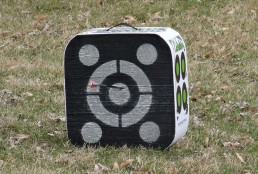Accurately Judging Distance: You Might Never Miss Again
SHARE THIS POST
In order to shoot an arrow with a quick, humane kill, you first need to be able to accurately judge the distance to your intended target. Whether if it’s with the aid of a laser rangefinder, stepping off distances to easily recognize landmarks or relying on pure instinct and practice, it is critical to know how far you are shooting.
After my nephew first purchased a new laser rangefinder with ARC capabilities, he could not conceal his excitement as he came to my home to show off the latest technology.
I will never forget what he said to me:
“With one of these, you will never miss a deer again.”
I don’t think I would make such a bold statement, but it does make things a lot easier. And I can’t blame him for his optimistic hopes.
A good rangefinder will not make the difference between always hitting your target and missing it. Hunters have to take into consideration “buck fever”—the deer “jumping the string,” such as an unseen branch. But guessing the incorrect distance doesn’t have to be one of the main reasons you miss.
With today’s technology, all you have to do is pick up a tiny device that fits in the palm of your hand, aim it at your target, hit a button and watch the distance appear in front of your eyes—no more guessing how far an animal is away.
When I first started bowhunting, I don’t recall there even being such a thing as a rangefinder. Today, many hunters would be at a loss without one. Like most electronics after they have been on the market for some time, these rangefinders have become user-friendly, and are at an affordable price.
Just about every optics manufacturer sells a rangefinder suitable for a bowhunter. A recent look through a hunting catalog revealed many models from several manufacturers providing a variety of options, pricing and those with a longer life and power when out hunting.
Are you enjoying this post?
You can be among the first to get the latest info on where to go, what to use and how to use it!
When purchasing one, I recommend buying a rangefinder with ARC (Angle Range Compensation) capabilities. This is a rangefinder with the capability that allows the hunter to aim the “true” distance to the target, not just the line-of-sight distance. When hunting and aiming down from a treestand, the line of sight is farther than what the target actually is. This will normally cause a shot to land too high on an animal, or even result in a miss.
Many hunters have a hard time judging uphill and downhill angles. A rangefinder will take that worry away with the ability to judge distances several hundred yards away within one-half yard.
Laser rangefinders are good, especially for those newer to available technology, but their batteries can grow weak and die suddenly and there may not be enough time to use it when you’re already afield for some time.
Practice makes perfect technology
Judging distances does not come natural for most, including myself. But in order to improve your skills you have to practice under different conditions and distances, even with technology at your side.
The best practice for a bowhunter is shooting on a 3-D course. Today’s 3-D targets are lifelike, and provide realistic sessions. I often place my personal targets in positions and terrain to imitate a hunting situation. And, don’t forget the opportunities of shooting at 3-D archery courses; they provide many targets of a variety of animals. Distances vary from very close, to far too, and the terrain is similar to the area you’re going to hunt for real.
Another technique I often use when hanging treestands or putting up blinds, is to walk off 10, 15, 20 and 25 yards, and make a mental note where those distances are from where I will be hunting and shooting. For example, my notes read: “Ten yards–small elderberry bush; 15 yards–6-foot spruce tree,” etc. I’ll do this for every treestand location and study my notes before or even during a hunt. Another option is to place a small strip of flag tape as high as you can reach in a tree at 5-yard increments. If you are using scent wicks, step off the distance they are from the tree you are hunting up in.
Even if you have a rangefinder, and as great as this technology is, we can’t always rely on it. As mentioned, about the time we are comfortable ranging a deer, the batteries can weaken and fail. And without a backup plan or the right practice before the season, we can be left unsure what to do next.
It doesn’t always necessarily matter how you judge distance, but it can mean the difference between harvesting an animal or not.
MWO
SHARE THIS POST
Did you enjoy this post?
You can be among the first to get the latest info on where to go, what to use and how to use it!
MWO
We believe being outdoors is good. With more than 1,000 articles each year, MidWest Outdoors magazine is all about sharing outdoor experiences with you—where to go, what to use and how to use it… whether you’re close to home or on that trip of a lifetime.




